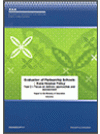The Ministry of Education has a clear focus on improving student achievement, and employs a range of approaches to support the sector’s efforts, including provision of strategic leadership, resources, and targeted interventions. Partnership Schools | Kura Hourua (PSKH) is a new policy that provides an innovative addition to this mix.
Partnership School│Kura Hourua policy
The PSKH policy has been implemented in two rounds to date: five schools/kura opened in February 2014 and a further four schools/kura opened in February 2015. The agreement with one of the Round 1 kura was terminated by the Minister of Education from 7 March 2016.
Purpose
MartinJenkins is conducting a multi-year evaluation of the PSKH policy for the Ministry. The overall purpose of the multi-year evaluation is to assess the extent to which the PSKH policy has delivered what it intended to deliver with regard to flexibility, innovation and student outcomes.1
This second year of evaluation focused on two things:
the approaches taken by PSKH, to understand better what the policy is delivering in practice
an in-depth analysis of schools' assessment practices and use of assessment data to inform decision-making in the classroom and across the school, as an important condition for success.
Year 2 of the evaluation used a mixed-method approach; drawing on document review, interviews and an online survey to develop a comprehensive understanding of school-level provision, supplemented by quantitative analysis of outcomes data, which was provided to the MartinJenkins evaluation team by the Ministry of Education. The research was undertaken in two parts.
Part 1 explored at a broad level the approaches schools/kura are taking to meet the needs of priority students. The research questions for Part 1 are:
- Who are the priority students and what are their needs?
- What are schools/kura doing to meet the needs of priority students?
- What is the rationale for approaches taken?
- What outcomes do schools/kura attribute to the approaches taken?
- What has enabled or prevented schools/kura from implementing desired approaches?
Part 2 explored in depth the assessment practices within schools/kura. The research questions for Part 2 are:
- What is the value of good assessment practice and what does best practice look like?
- What does assessment practice and information use look like in the schools/kura?
- What is the quality of schools'/kura's assessment practice and information use?
- What is the relationship between assessment practice and student achievement outcomes?

